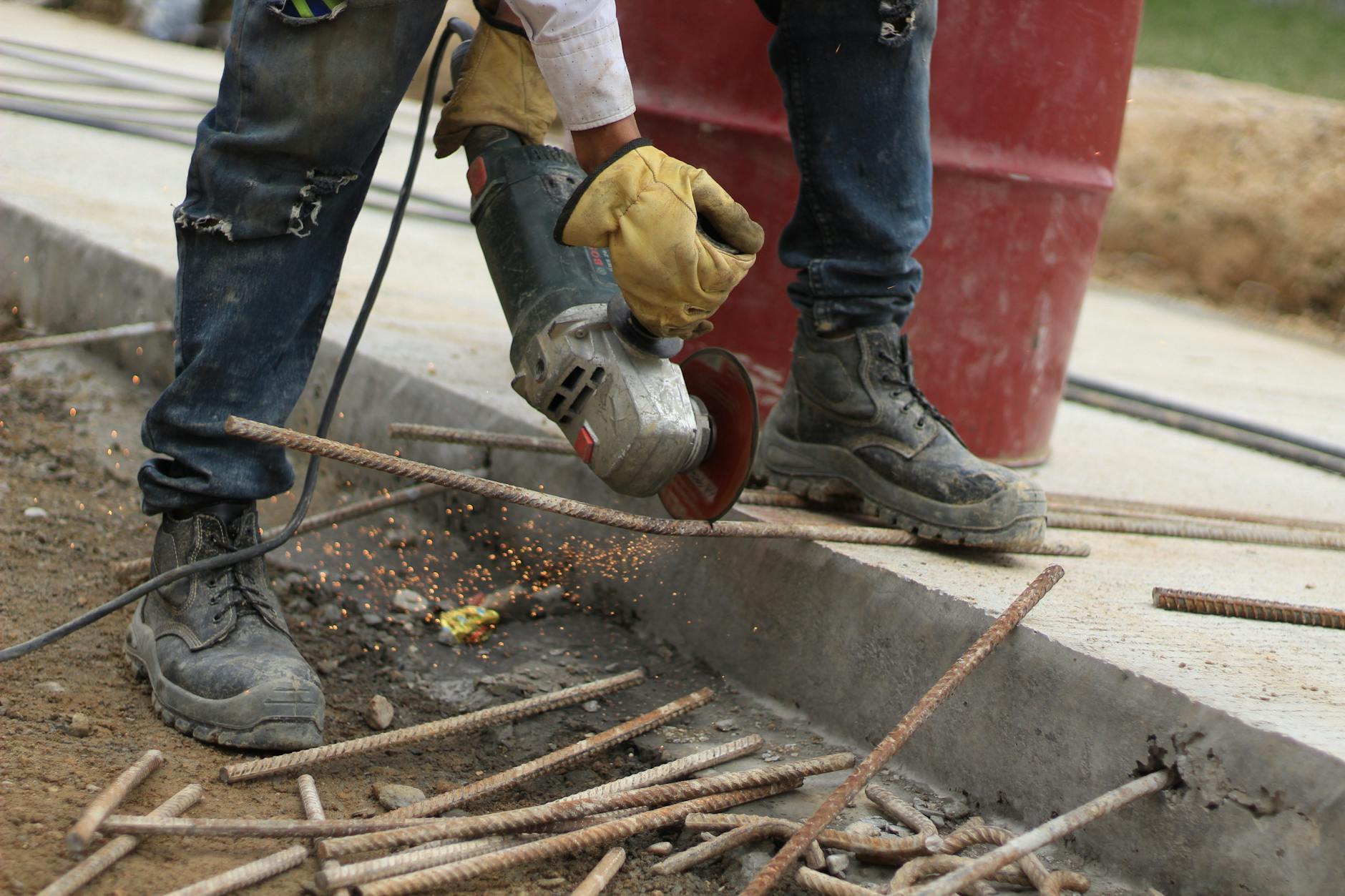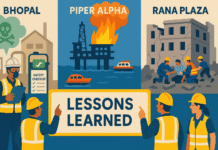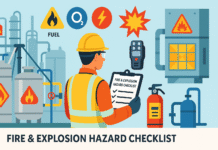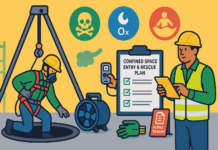
Rebar Cutting and Bending JSA – Job Safety Analysis
1. Introduction
Reinforcing bars (rebar) are essential in reinforced concrete structures, providing tensile strength to complement concrete’s compressive capacity. Cutting and bending rebar are routine construction activities but involve significant safety hazards such as cuts, crushing injuries, flying debris, noise exposure, and ergonomic strain.
A Job Safety Analysis (JSA) for rebar cutting and bending ensures that every stage of the job is evaluated for hazards, risk levels are determined, and effective controls are implemented before work begins.
2. Purpose of This JSA
The objectives of this JSA are to:
- Identify hazards associated with rebar cutting and bending activities.
- Establish safe work procedures to prevent injury and property damage.
- Ensure compliance with occupational safety regulations.
- Promote hazard awareness and proper use of safety equipment.
3. Applicable Standards & References
- OSHA 29 CFR 1926.703 – Requirements for reinforcing steel
- IS 456 – Code of Practice for Reinforced Concrete
- IS 1786 – High Strength Deformed Steel Bars and Wires for Concrete Reinforcement
- ISO 45001 – Occupational Health and Safety Management Systems
- Company-specific Rebar Cutting and Bending Procedure
4. Scope of Work
This JSA applies to:
- Manual rebar cutting using hand tools.
- Machine-based cutting (electric or hydraulic).
- Manual bending using bending tables.
- Machine bending using powered benders.
- On-site fabrication of rebar cages or stirrups.
5. Step-by-Step JSA Process for Rebar Cutting & Bending
Step 1: Job Breakdown
- Pre-job planning and inspection of work area.
- Delivery and stacking of rebar.
- Measuring and marking rebar for cutting.
- Cutting rebar (manual or mechanical).
- Bending rebar (manual or mechanical).
- Bundling and transporting cut/bent rebar to storage or work location.
- Cleaning and maintaining equipment.
Step 2: Hazard Identification
Common hazards include:
- Cuts and puncture wounds from sharp rebar ends.
- Crushing injuries from dropped bars or machine parts.
- Flying debris during cutting operations.
- Noise exposure from cutting/bending machines.
- Ergonomic strain from repetitive bending or awkward lifting.
- Electrical hazards from powered equipment.
- Slips and trips due to cluttered work area.
Step 3: Risk Assessment Table
| Task | Hazard | Potential Consequence | Risk Rating | Control Measures |
|---|---|---|---|---|
| Unloading and stacking rebar | Struck-by or crushed by shifting load | Serious injury | High | Use mechanical aids, stack properly |
| Measuring and marking | Contact with sharp edges | Cuts | Medium | Gloves, file burrs before handling |
| Cutting rebar (machine) | Flying debris, entanglement | Eye injury, amputation | High | Machine guards, face shield |
| Cutting rebar (manual) | Muscle strain, tool slip | Back injury, cuts | Medium | Proper posture, sharp tools |
| Bending rebar | Pinch points, flying ends | Hand injury, eye injury | High | Use bending jigs, safety glasses |
| Transporting cut/bent rebar | Manual handling | Back strain | Medium | Team lift, mechanical aids |
6. Control Measures
A. Engineering Controls
- Use machine guards on cutters and benders to prevent contact with moving parts.
- Install safety stops to control rebar movement during bending.
- Maintain non-slip flooring in work area.
- Provide adequate lighting to improve visibility.
B. Administrative Controls
- Only trained and authorized personnel to operate cutting/bending machines.
- Conduct pre-use equipment inspections.
- Establish safe lifting techniques and team lifting procedures.
- Enforce a clear workspace policy to reduce tripping hazards.
- Schedule rest breaks for workers performing repetitive tasks.
C. Personal Protective Equipment (PPE)
- Safety helmet.
- Safety goggles or face shield.
- Cut-resistant gloves.
- Safety boots with steel toe.
- Hearing protection (when noise exceeds limits).
- Long-sleeved clothing to protect against sharp edges.
7. Roles & Responsibilities
- Site Manager – Approves work plan, allocates resources.
- Supervisor – Ensures safe work practices and proper PPE usage.
- Operator – Follows safe operation procedures for cutting/bending.
- Helper – Assists with safe loading/unloading of rebar.
- Safety Officer – Conducts inspections, enforces compliance.
8. Emergency Preparedness
- First aid kit available at the worksite.
- Emergency contact numbers displayed prominently.
- Eye wash station available in case of debris injury.
- Emergency stop switches clearly marked and functional on machines.
- Rescue plan for entanglement or serious injury scenarios.
9. Best Practices for Rebar Cutting & Bending Safety
- File or cap exposed rebar ends to prevent impalement hazards.
- Do not exceed the rated capacity of cutting/bending machines.
- Keep hands and clothing clear of moving parts.
- Store rebar horizontally on racks, secured to prevent rolling.
- Remove scrap pieces promptly to prevent trips and falls.
10. Sample JSA Form – Rebar Cutting and Bending
Job Title: Rebar Cutting and Bending
Location: ________________________
Date: ________________________
Supervisor: ________________________
| Task Step | Hazard | Control Measure | PPE Required | Responsible Person |
|---|---|---|---|---|
| Unloading rebar | Struck-by | Mechanical aids, proper stacking | Helmet, gloves | Crew |
| Measuring/marking | Cuts | Gloves, file edges | Gloves | Worker |
| Cutting (machine) | Flying debris | Machine guard, face shield | Goggles, gloves | Operator |
| Bending rebar | Pinch points | Use bending jigs | Gloves, goggles | Operator |
| Transporting | Back strain | Team lift | Gloves, boots | Crew |
11. Conclusion
A Rebar Cutting and Bending JSA is essential to safeguard workers, prevent costly accidents, and maintain productivity. The key to safe rebar work lies in engineering controls, skilled operators, disciplined procedures, and proper PPE use.
✅ Final Safety Reminder:
“Strong structures start with safe steelwork — protect your hands, eyes, and back before you start the cut or bend.”
Scaffold Erection and Dismantling JSA – Job Safety Analysis
Manual Material Handling HIRA – Top 10 Ergonomic Hazards and the Ultimate Safety Blueprint
Electrical Work HIRA – Top 10 Critical Hazards and the Ultimate Safety Blueprint
Confined Space Entry HIRA – Top 10 Deadly Hazards and the Ultimate Safety Guide
Lifting and Rigging Operations HIRA – Top 10 Critical Hazards and the Ultimate Safety Guide
























